What's New
Displaying results 301 - 310 of 4052
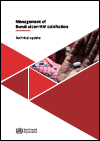
Resource | Publications,
Areas of Africa endemic for Buruli ulcer (BU), caused by Mycobacterium ulcerans, also have a high prevalence of human immunodeficiency virus (HIV), with adult prevalence rates between 1% and 5%. However, there is limited information on the prevalence of BU–HIV coinfection. Preliminary evidence suggests that HIV infection may increase the risk of BU disease. In the Médecins Sans Frontières project in Akonolinga, Cameroon, HIV prevalence was approximately 3–6 times higher among BU patients than the regional estimated HIV prevalence. Similarly in Benin and Ghana, BU patients were 8 times and 3 times respectively more likely to have HIV infection than those without BU. Further study is needed to clarify this association and enhance knowledge about the prevalence of BU–HIV coinfection in endemic areas.
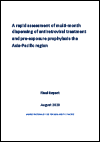
Resource | Publications,
The purpose of this rapid assessment1 is to investigate the current status of multi-month dispensing (MMD) in 14 countries in the Asia-Pacific region of UNAIDS - Bangladesh, Cambodia, China, Fiji, India, Indonesia, Laos, Myanmar, Nepal, Pakistan, Philippines, Papua New Guinea, Thailand and Vietnam. It aims to determine the current stages of MMD implementation, identify good practices, factors enabling successful MMD implementation as well as barriers and bottlenecks. It will also investigate MMD with regard to pre-exposure prophylaxis (PrEP) in the two countries where PrEP programming is currently being implemented (Thailand and Vietnam).
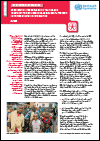
Resource | Publications,
This policy brief highlights key elements of the 2020 WHO consolidated HIV strategic information guidelines pertinent to HIV testing and treatment for children. It is designed to support country strategic information teams to choose, collect and systematically analyse the strategic information needed to strengthen programme management and monitoring of testing and treatment for children and adolescents.
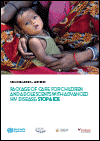
Resource | Publications,
The major causes of morbidity and mortality among children living with HIV in low- and middle-income countries are pneumonia (including Pneumocystis pneumonia), tuberculosis (TB), bloodstream infections, diarrhoeal disease and severe acute malnutrition. In addition, for adolescents living with HIV, adult-type opportunistic infections also occur, including cryptococcal meningitis. WHO published guidelines on the management of advanced HIV disease in 2017, promoting a package of interventions to prevent, identify and treat HIV-associated infections among people with advanced HIV disease. This publication builds on the 2017 guidelines and highlights existing WHO recommendations and implementation considerations that are relevant to the care of children and adolescents with advanced HIV disease. It is therefore not meant to be a comprehensive review of all severe comorbidities that affect children living with HIV. In addition, many of the interventions described here are also relevant for children and adolescents living with HIV who do not have advanced disease.
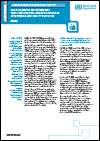
Resource | Publications,
In April 2020, new directions in global guidance for HIV strategic information and treatment monitoring were updated. This technical update outlines the key developments with respect to recommended indicators and approaches and tools for monitoring antiretroviral drug toxicity with the purpose of strengthening country implementation and ensuring the safe use of antiretroviral drugs.

Resource | Infographics,
This decision tree guides data collectors through the various considerations, viable options, and alternative data sources for obtaining information without jeopardizing participants’ safety or the data’s integrity. In doing so, it aims to identify data sources and methodologies that are useful for strengthening services and referral pathways for women experiencing violence during COVID-19.

Resource | Publications,
Supported by photos, data, infographics, and individual impact stories, the annual report highlights key achievements of the 18 active projects in 2019. It offers a snapshot of the impact the global pandemic caused by COVID-19 on grantees and the populations they serve, and the ways they are responding to it. Finally, it presents the results from its latest efforts to accelerate progress by fostering innovation and peer learning.
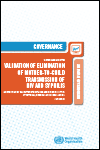
Resource | Publications,
This governance guidance provides further detail on the standardized structure and processes used to validate the elimination of the mother-to-child transmission (EMTCT) of HIV and syphilis. This publication serves alongside and as a supplement to the Global guidance on the criteria and processes for validation: elimination of mother-to-child transmission of HIV and syphilis (global EMTCT guidance), the four country assessment tools on EMTCT of HIV and syphilis and the pre-assessment tool on EMTCT of HIV and syphilis and termed path to elimination (PTE). In the interim between the publication of this governance guidance in 2020 and the planned third edition of the global EMTCT guidance elimination of mother-to-child transmission of HIV and syphilis, the governance structures and processes in this publication serve as the most current methods to be applied to the country review and validation process.
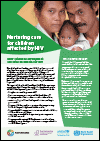
Resource | Publications,
Over the last three decades, scientific findings from a range of disciplines have converged. They prove that in the early years, we lay down critical elements for health, well-being and productivity, which last throughout childhood, adolescence and adulthood. Failure to meet a child’s needs during this critical period limits the child’s ability to achieve their full developmental potential and threatens the future of human capital and society in general.
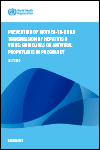
Resource | Guidelines,
WHO estimates that in 2015, 257 million people were living with chronic hepatitis B virus (HBV) infection worldwide, and that 900 000 had died from HBV infection, mostly as a result of cirrhosis or hepatocellular carcinoma. Most HBV-associated deaths among adults are secondary to infections acquired at birth or in the first five years of life. In May 2016, the World Health Assembly endorsed the Global health sector strategy on viral hepatitis, which calls for the elimination of viral hepatitis as a public health threat by 2030 (defined as a 90% reduction in incidence of new infections and a 65% reduction in mortality). Elimination of HBV infection as a public health threat requires a reduction in the prevalence of hepatitis B surface antigen (HBsAg) to below 0.1% in children 5 years of age. This can be achieved through universal immunization of newborns against hepatitis B and other interventions to prevent mother-to-child transmission of HBV.
These guidelines provide evidence-based guidance on the use of peripartum antiviral prophylaxis in HBsAg-positive pregnant women for the prevention of mother-to-child transmission of HBV.





